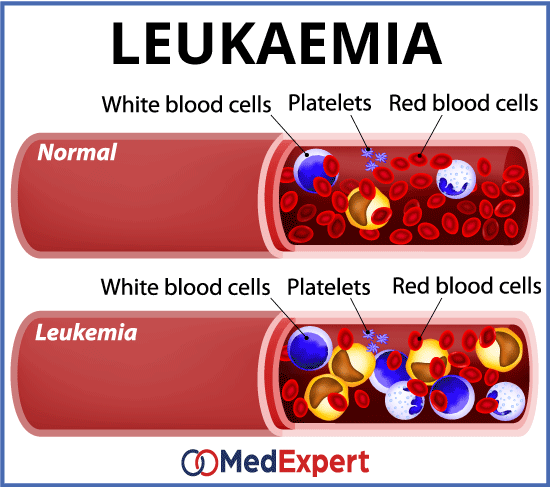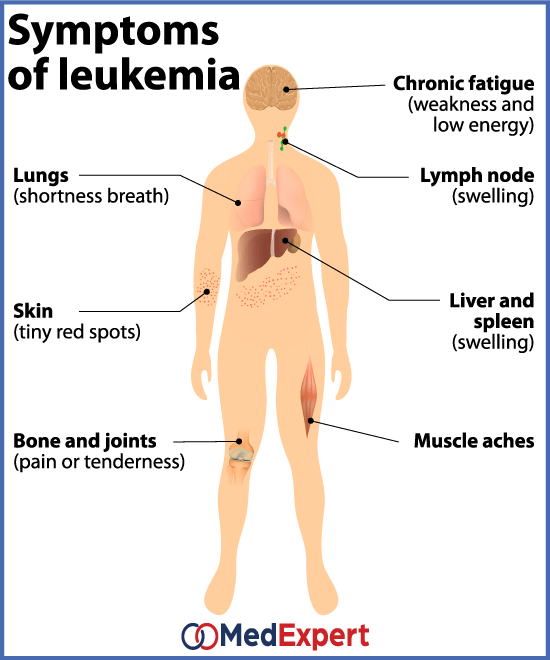LEUKAEMIA
A type of cancer that starts in the blood-producing tissues, is referred to as leukaemia. Depending on the type of blood cells this disease affects, doctors distinguish different leukaemia types. Most common leukaemia symptoms include fever, chills, persistent fatigue, etc. Leukaemia treatment depends on many factors and may include chemotherapy, radiation, stem cell transplant and targeted therapy. More detailed information about this condition, symptoms is causes, diagnostic services, as well as leukemia treatment options, presented below.
Leukaemia starts in blood-forming tissue, normally the bone marrow. This cancer leads to an over-production of abnormal white blood cells which is the part of the immune system that defends your body against infections. Bone marrow is the spongy tissue in your bones forming blood cells. Over time, blood-forming stem cells divide either to produce more steam cells or immature cells that become mature blood cells in a while. Blood stem cells can turn into myeloid or lymphoid stem cells. White blood cells are affected and can be classified by the type of white cell affected:

- Myeloid cells
- Lymphatic cells
Or by the progress of the disease:
- Acute
- Chronic
Acute and chronic refer to how rapidly the disease progresses and not to how serious the condition is.
HOW MANY LEUKAEMIA TYPES ARE THERE?
- Acute myeloid leukaemia (AML): Develops rapidly and affects myeloid cells (granulocytes)
- Chronic myeloid leukaemia (CML): Develops slowly and affects myeloid cells (granulocytes)
- Acute lymphoblastic leukaemia (ALL): Develops rapidly and affects lymphocytes
- Chronic lymphocytic leukaemia (CLL): Develops slowly and affects lymphocytes
LEUKAEMIA SYMPTOMS
Lack of normal blood cells is more commonly the cause of symptoms rather than the presence of abnormal white cells in most types of leukaemia. As leukaemia cells fill up the bone marrow, it becomes incapable of producing necessary amounts of normal blood cells that the body needs. This will lead to:
- Anaemia as red blood cells deplete
- Weakness and tiredness
- Shortness of breath
- Light-headedness
- Palpitations
- Frequent infections that are more severe and last longer due to the lack of normal white blood cells
- Fever, malaise (feeling ill) and sweats
- Small bruises in skin (Purpura)
- Bleeding and bruising such as heavy period, nosebleeds and bleeding gums due to the lack of platelets

Some symptoms are only experienced in certain patients or in certain forms of leukaemia. For instance, young children with acute lymphoblastic leukaemia (ALL) may complain of pain in bones and joints. On the other hand, acute myeloid leukaemia (AML) may have swollen gums from the presence of leukaemia cells in the tissues. Lymph nodes may become swollen in lymphoid malignancies. Some forms of leukaemia may result in liver enlargement (hepatomegaly) or the spleen enlargement (splenomegaly).
LEUKAEMIA TREATMENT OPTIONS
Not all patients with this type of cancer start treatment immediately. Some patients who are not receiving treatment, have regular check-ups known as “watch and wait” or “active monitoring”. This is mainly relevant to patients with chronic lymphocytic leukaemia (CLL). In fact, some patients with CLL may never need to get treated. However, almost all patients with CML or with acute leukaemia start treatment after diagnosis. Even though, patients who are actively monitoring their disease don’t experience any side effects of treatment, it can be a nerve-wrecking time. It is important to let your health care team know if your experience anxiousness as they can offer support and reassurance. Standard treatments can normally cure acute form of this disease. Chronic leukaemia on the other hand is not curable but the good news is, it is treatable. Even though most patients with acute leukaemia have good responses to the treatments initially, the diseases may sometimes return. This is a relapse and can normally be treated again using similar treatments used as the first time. The main ways to treat leukaemia are:
Chemotherapy
This treatment uses chemicals (cytotoxics) to kill cells especially the ones that multiply quickly like cancer cells. This is the main form of treatment for cancer. It is usually given as a combination of drugs. The cancer is targeted by the different drugs in different ways and also produces different side effects. For this reason, a combination treatment is more effective than using a single drug when controlling your disease and it also keeps your side effects to a minimum.
This treatment is normally given in cycles or courses with rest time in between. The rest periods allow the body to recover from the side effects. In most cases, you won’t need to be admitted to the hospital to receive treatment. It can usually be taken at home or given at the hospital’s day treatment center. However, depending on the type of chemotherapy received and your general health, you may sometimes need to be admitted for a short while. What is important to note is that chemotherapy is a protocol of administering a certain cocktail of drugs based on the unique patient condition and stage of cancer. Different doctors, with their own individual experiences might prescribe a different dosage, duration, different drugs etc. Hence it is important to find a doctor that has adequate experience and also works in the patient best interest when subscribing to a chemotherapy treatment plan.
Radiation therapy
Also known as radio therapy, this treatment uses high energy X-rays to kill cancer cells and to shrink tumours. This treatment is also regarded as local therapy as it only destroys cancer cells in the treated area.
The area of the body that is being treated is known as the radiation field. “Involved field therapy” is sometimes used to describe radio therapy given to a local area. The area of healthy tissues is kept to the smallest area possible. Common fields include:
- Mantle field (treating the lymph nodes of the neck, chest and armpit)
- Upper abdominal field (abdomen and sometimes spleen)
- Pelvic field (hips and groin) and the spine
The radiation oncologist will carefully calculate the correct dose of radiation for you before you start the therapy. Tiny ink dots will be marked on the affected area using a special pen. The radiotherapy is given in fractions each weekday (Monday to Friday) over a week or more at the Hospital’s radiotherapy department. You will not be admitted to the Hospital but if you live further away, you may want to look into organising a closer accommodation during this time. You will be required to lie on a table under the radio therapy machine. This machine will send the planned dose of radiation.
If necessary, important structures of your body like your heart and lungs are shielded as much as possible to make sure they are not affected by the treatment. This treatment is painless. You will not feel anything during the treatment. However, you will be required to stay still for a few minutes while the treatment takes place. You may like to bring some music to help you relax.
Targeted therapy
Monoclonal antibodies and inhibitors are used in targeted therapy. Inhibitors are usually used when treating leukaemia. The actions of specific cells such as imatinib mesylate (Glivec) belong to a class of drugs known as tyrosine kinase inhibitors. When specific cells such as cancer cells get blocked or stopped by inhibitors, the growth and development of the cells are prevented.
Imatinib binds a specific type tyrosine kinase called bcr-ABL. This is found on the surface that is Philadelphia chromosome positive (Ph+). Patients with Chronic Myeloid Leukaemia (CML) and patients with some forms of Acute Lymphoblastic Leukaemia (ALL) have these cells. Treatment can be consumed in tablets or capsules at the comfort of your own home and is well tolerated by most patients. In the treatment of CML and across a range of cancers, new inhibitors are being developed. For CML, they are often given as a sole treatment agent but may also be used as maintenance for ALL. Side effects are present but are mild and reduce over time. These side effects include fatigue, skin reactions, mild gastric upsets and fluid retention.
Stem cell transplant
To restore healthy bone marrow in patients with leukaemia, this treatment may be used. Stem cells can help to stimulate new healthy bone marrow growth and restore the immune system.
You will be required to undergo a conditioning regimen before a stem cell transplant. This treatment involves intensive therapy that kills as many affected cells as possible. High doses of chemotherapy and sometimes radiation therapy may be used. Reduced-intensity conditioning called a mini-allogenic transplant and/or a total body irradiation (TBI) may also be given before transplant. You will be ready for transplant once the preparation regimen is done. You will receive the stem cells intravenously similar to a blood transfusion. The stem cells make its way to the bone marrow and start making new blood cells after entering the blood stream. This process is known as engraftment. The procedure takes about an hour.
In the following months after transplant, your care team will monitor your blood counts. Transfusions of red blood cells and platelets may be needed. Sometimes, the intensive preparation regimen may cause side effects such as infections. Your doctor will administer IV antibiotics if this happens. Certain drugs may be prescribed to reduce the risk of graft-versus-host-disease (GVHD) if you underwent an allogeneic stem cell transplant. GVHD is a condition where the donated cells attack the patient’s tissues.
DIAGNOSING LEUKAEMIA
Doctors may suspect that you have leukaemia based on signs and symptoms. However, it can only be diagnosed by laboratory tests.

- Physical exam: Your doctor will look for physical signs of leukaemia, such as pale skin from anaemia, swelling of your lymph nodes, and enlargement of your liver and spleen.
- Blood tests: A simple blood count test results can normally indicate leukaemia. Very rarely, a blood count may come out normal.
- Bone marrow test: A procedure involving the removal of a sample of bone marrow from your hipbone may be recommended by your doctor. This is done by using a long and thin needle. The sample is then sent to a lab to test for leukaemia cell. Certain characteristics of your leukaemia cells may be revealed through specialized tests. The results are then used to determine your treatment options.


